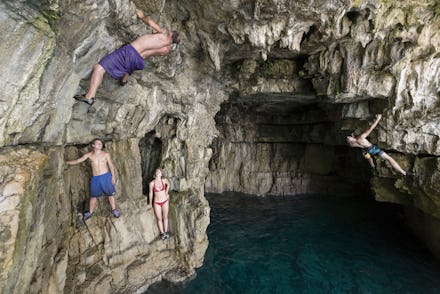When It Comes to Romance, Science Has Good News for Adrenaline Junkies

We may scoff at the elaborate, death-defying dates that The Bachelor comes up with. But it turns out there's actually something to those thrill-seeking dates (and no, it's not just that they're lame metaphors for relationships).
For those who prefer their first dates to include rock-climbing or biking over dinner and a movie, science has good news: Moments of anxiety and adrenaline rushes can actually lead to sexual attraction.
The science behind arousal: The key is the link between arousal and attraction, research has found. Arousal is both neurological and physical, with the brain releasing neurotransmitters in response to stimuli and the body reacting with its own more obvious responses.
You would think that arousal is always the result of sexual attraction. But it turns out the reverse it also true. In 1973, in what ended up being one of the most famous studies on the psychology of attraction, psychologists Donald Dutton and Arthur Aron set out to reveal that physical arousal — specifically, reactions to scary situations — can actually impact sexual attraction.
The study's main experiment had men between the ages of 18 and 35 approach an attractive woman. Some had to cross high, rickety bridge to reach her, and others only needed to cross a low, stable bridge. At the end of each bridge, the woman gave the men a questionnaire. She then told them that if they wanted to know more about the questionnaire, they could call her, and she handed over her phone number.
The result: The men on the shaky bridge included more sexual content and imagery in their questionnaire responses than the safe bridge-crossers. Moreover, only two out of the 16 participants on the low bridge called the woman, while half of the 18 participants on higher bridge took the opportunity to call her afterward.
To the psychologists, the study said something intriguing about sexual attraction: It can transpire from arousal in the form of fear. "The results of these studies," they wrote in 1974, "would seem to provide a basis of support for an emotion-sexual attraction link."
Subsequent studies have found the same link between sheer physical arousal and sexual attraction. In a 2003 study of non-romantic partners on roller coaster rides, researchers found that "ratings of attractiveness and dating desirability toward a photographed individual were substantially higher among those who had completed" the ride, noting that "residual arousal from riding a roller-coaster intensified participants' later experience of attraction."
The physical arousal doesn't even have to be fear-based. A 2011 study conducted by undergraduates asked participants to fill out a survey regarding their attraction to those of the opposite sex after completing 15 minutes of physical activity. The researchers found that the increase of adrenaline from exercise resulted increased levels of attraction between members of the opposite sex.
What's really turning you on: Feelings, as we struggling humans know, can be interpreted in multiple ways. That confusion may be what's behind the arousal-attraction link; researchers call it "misattribution of arousal." All sorts of stimuli can "arouse" you, getting your blood pumping and hormones flying; parachuting out of a plane and being mugged, for example, elicit similar bodily responses.
In certain instances, when arousal from fear or intense physical activity resembles sexual arousal and there is an object presence, the brain may connect the arousal to sexual attraction — in essence, a misattribution error. As Dutton and Aron put it in their study, "Strong emotions are relabeled as sexual attraction whenever an acceptable object is present."
Other researchers have similarly argued that the arousal sprung from the nervous system transfers and is then interpreted as sexual attraction. It's in those moments of heightened anxiety that feelings of excitement and even fear can evolve into arousal and sexual attraction. Even something as simple as a ride on a roller coaster can affect your attraction toward someone before and after the ride.
Real love, of course, relies on more than fleeting arousal. But even love involves physiological arousal, including quicker heartbeats and an adrenaline rush. When someone sees the person they love, their brain signals the adrenal gland. The resulting physical effects can feel similar to those you experience after a run.
A real-life dating strategy: Just because the attraction may be "misattributed" doesn't mean it's not really happening or can't actually result in real attraction. It's all about the right context. For thrill-seekers and adventure junkies, planning dates that contain these aspects is really playing in their favor.
We wouldn't recommend taking dating advice from The Bachelor, but the show did get one thing right: Taking advantage of how the body transfers anxiety into sexual attraction, and having good time in the process, might just be the perfect date.